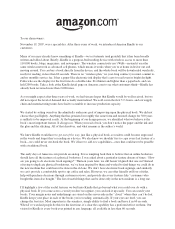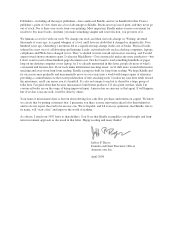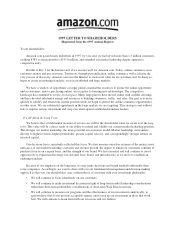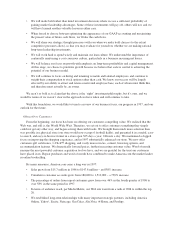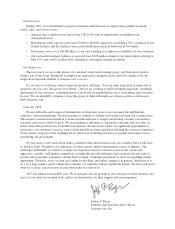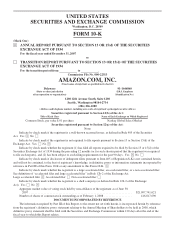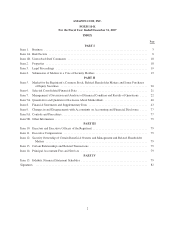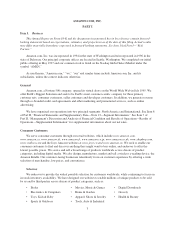Amazon.com 2007 Annual Report Download - page 3
Download and view the complete annual report
Please find page 3 of the 2007 Amazon.com annual report below. You can navigate through the pages in the report by either clicking on the pages listed below, or by using the keyword search tool below to find specific information within the annual report.
To our shareowners:
November 19, 2007, was a special day. After three years of work, we introduced Amazon Kindle to our
customers.
Many of you may already know something of Kindle—we’re fortunate (and grateful) that it has been broadly
written and talked about. Briefly, Kindle is a purpose-built reading device with wireless access to more than
110,000 books, blogs, magazines, and newspapers. The wireless connectivity isn’t WiFi—instead it uses the
same wireless network as advanced cell phones, which means it works when you’re at home in bed or out and
moving around. You can buy a book directly from the device, and the whole book will be downloaded wirelessly,
ready for reading, in less than 60 seconds. There is no “wireless plan,” no year-long contract you must commit to,
and no monthly service fee. It has a paper-like electronic-ink display that’s easy to read even in bright daylight.
Folks who see the display for the first time do a double-take. It’s thinner and lighter than a paperback, and can
hold 200 books. Take a look at the Kindle detail page on Amazon.com to see what customers think—Kindle has
already been reviewed more than 2,000 times.
As you might expect after three years of work, we had sincere hopes that Kindle would be well received, but we
did not expect the level of demand that actually materialized. We sold out in the first 5
1
⁄
2
hours, and our supply
chain and manufacturing teams have had to scramble to increase production capacity.
We started by setting ourselves the admittedly audacious goal of improving upon the physical book. We did not
choose that goal lightly. Anything that has persisted in roughly the same form and resisted change for 500 years
is unlikely to be improved easily. At the beginning of our design process, we identified what we believe is the
book’s most important feature. It disappears. When you read a book, you don’t notice the paper and the ink and
the glue and the stitching. All of that dissolves, and what remains is the author’s world.
We knew Kindle would have to get out of the way, just like a physical book, so readers could become engrossed
in the words and forget they’re reading on a device. We also knew we shouldn’t try to copy every last feature of a
book—we could never out-book the book. We’d have to add new capabilities—ones that could never be possible
with a traditional book.
The early days of Amazon.com provide an analog. It was tempting back then to believe that an online bookstore
should have all the features of a physical bookstore. I was asked about a particular feature dozens of times: “How
are you going to do electronic book signings?” Thirteen years later, we still haven’t figured that one out! Instead
of trying to duplicate physical bookstores, we’ve been inspired by them and worked to find things we could do in
the new medium that could never be done in the old one. We don’t have electronic book signings, and similarly
we can’t provide a comfortable spot to sip coffee and relax. However, we can offer literally millions of titles,
help with purchase decisions through customer reviews, and provide discovery features like “customers who
bought this item also bought.” The list of useful things that can be done only in the new medium is a long one.
I’ll highlight a few of the useful features we built into Kindle that go beyond what you could ever do with a
physical book. If you come across a word you don’t recognize, you can look it up easily. You can search your
books. Your margin notes and underlinings are stored on the server-side in the “cloud,” where they can’t be lost.
Kindle keeps your place in each of the books you’re reading, automatically. If your eyes are tired, you can
change the font size. Most important is the seamless, simple ability to find a book and have it in 60 seconds.
When I’ve watched people do this for the first time, it’s clear the capability has a profound effect on them. Our
vision for Kindle is every book ever printed in any language, all available in less than 60 seconds.



